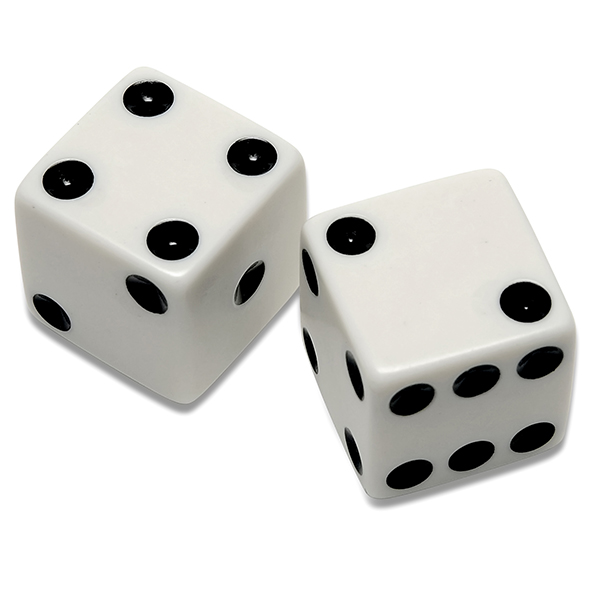Loops
Contents
Loops#
from datascience import *
from cs104 import *
import numpy as np
%matplotlib inline
2. Simulation#
Random Selection#
dice = np.arange(1,7)
dice
array([1, 2, 3, 4, 5, 6])
Here, np.random.choice randomly picks one item from the array and it is equally likely to pick any of the items.
np.random.choice(dice)
2
We can repeat the process by calling a second argument.
np.random.choice(dice, 10)
array([3, 1, 4, 1, 2, 1, 2, 4, 3, 6])
Of 100 rolls, how many of them equal 6?
rolls = np.random.choice(dice,100)
np.count_nonzero(rolls == 6)
17
What’s the mean of all the rolls?
np.mean(rolls)
3.52
Simulating the Question#
N = 1000000 #Roll the dice 1 million times
option_a = np.random.choice(dice, N) + np.random.choice(dice, N)
option_b = 2 * np.random.choice(dice, N)
print("Option A Mean: ", np.mean(option_a))
print("Option B Mean: ", np.mean(option_b))
Option A Mean: 6.995796
Option B Mean: 7.004524
samples = Table().with_columns("Option A", option_a, "Option B", option_b)
samples.hist("Option A", bins=np.arange(0,14))
samples.hist("Option B", bins=np.arange(0,14))
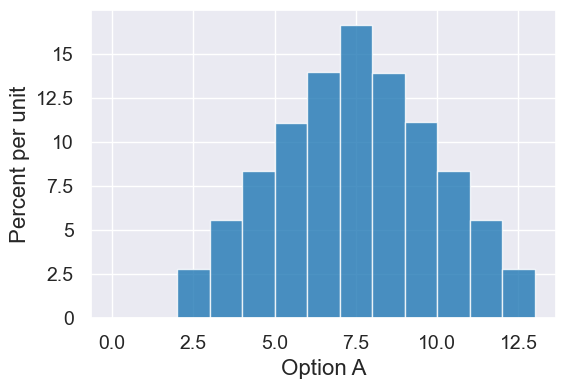
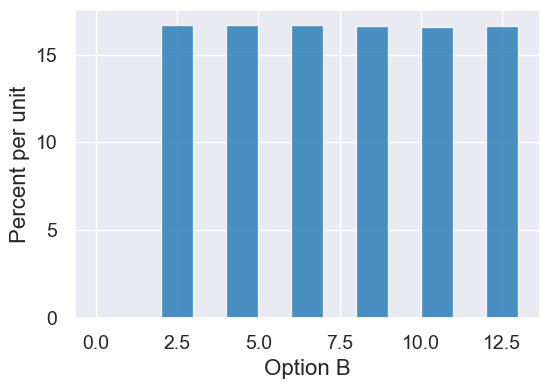
samples.hist(bins=np.arange(0,14))
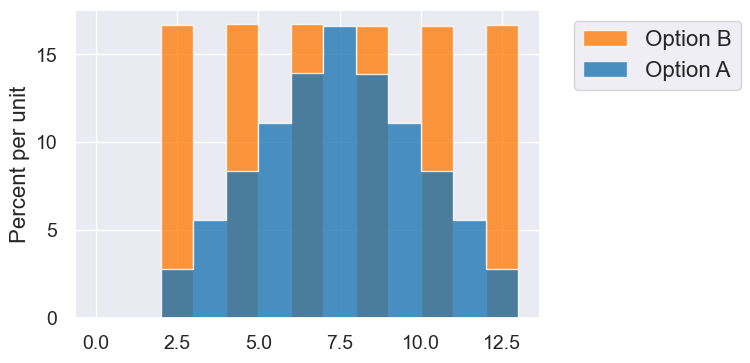
3. Loops#
How can we compute the average roll in option_a without using np.mean?
sum(option_a) / len(option_a)
6.995796
What if we can’t use sum?
We need to be able to do the same thing to every element in the array, namely add it to a tally we’re keeping. Loops let us do the same thing repeatedly.
np.arange(0, 5)
array([0, 1, 2, 3, 4])
for i in np.arange(0,5):
print("iteration", i)
iteration 0
iteration 1
iteration 2
iteration 3
iteration 4
Within the for loop, we often update variables and accumulate values.
option_a
array([4, 3, 6, ..., 6, 6, 5])
total = 0
for i in option_a:
total = total + i
print('total =',total, ' average =', total / len(option_a))
total = 6995796 average = 6.995796
Let’s generalize this function! We’ve been using sum all along but now we have the tools to build sum ourselves.
def sum(numbers):
total = 0
for i in numbers:
total = total + i
return total
sum(option_a)
6995796
How do we change sum to only sum up the odd numbers in numbers?
def sum_odd(numbers):
total = 0
for i in numbers:
if i % 2 == 1:
total = total + i
return total
sum_odd(option_a)
3497520
Ooo! An if inside a for loop!
You can iterate over other types of arrays too:
for fruit in make_array("Bananas",
"Apples",
"Oranges"):
print(fruit)
Bananas
Apples
Oranges
for value in np.arange(0,3):
print(value)
0
1
2
trees = Table().read_table('data/hopkins-trees.csv').take(0,1,2)
for tree in trees.column('common name'):
print(tree)
Maple, striped
Maple, red
Maple, sugar
4. Simulation using loops#

Simulating One Trial#
coin = make_array('heads', 'tails')
np.random.choice(coin)
'heads'
flips = np.random.choice(coin, 100)
flips
array(['heads', 'heads', 'heads', 'heads', 'tails', 'heads', 'heads',
'tails', 'tails', 'tails', 'heads', 'heads', 'tails', 'tails',
'heads', 'tails', 'tails', 'tails', 'tails', 'heads', 'tails',
'tails', 'tails', 'heads', 'heads', 'tails', 'heads', 'heads',
'tails', 'heads', 'tails', 'tails', 'heads', 'tails', 'heads',
'tails', 'heads', 'heads', 'heads', 'heads', 'tails', 'tails',
'tails', 'tails', 'tails', 'tails', 'tails', 'heads', 'tails',
'heads', 'heads', 'heads', 'heads', 'tails', 'heads', 'tails',
'heads', 'tails', 'heads', 'tails', 'heads', 'tails', 'tails',
'tails', 'tails', 'tails', 'tails', 'heads', 'tails', 'heads',
'heads', 'tails', 'tails', 'tails', 'heads', 'tails', 'tails',
'heads', 'tails', 'tails', 'tails', 'heads', 'tails', 'tails',
'tails', 'heads', 'heads', 'tails', 'heads', 'heads', 'heads',
'tails', 'tails', 'heads', 'tails', 'tails', 'heads', 'tails',
'tails', 'heads'], dtype='<U5')
np.count_nonzero(flips == 'heads')
44
The same code inside a function:
def heads_in_100_flips():
""" Returns the number of heads in 100 flips of
a fair coin """
coin = make_array('heads', 'tails')
flips = np.random.choice(coin, 100)
return np.count_nonzero(flips == 'heads')
Run it a bunch!
heads_in_100_flips()
43
Appending to an array of outcomes#
outcomes = make_array()
One simulation: run it a bunch!
num_heads = heads_in_100_flips()
outcomes = np.append(outcomes, num_heads)
outcomes
array([51.])
Let’s use a for loop to repeat 1000 times the outcome we care about–counting the number of heads in 100 flips.
outcomes = make_array()
num_trials = 10000
for i in np.arange(0, num_trials):
num_heads = heads_in_100_flips()
outcomes = np.append(outcomes, num_heads)
outcomes
array([55., 52., 51., ..., 55., 47., 54.])
simulated_results = Table().with_column('Heads in 100 flips',
outcomes)
plot = simulated_results.hist(bins=np.arange(30, 70, 1))
plot.interval(40,60)
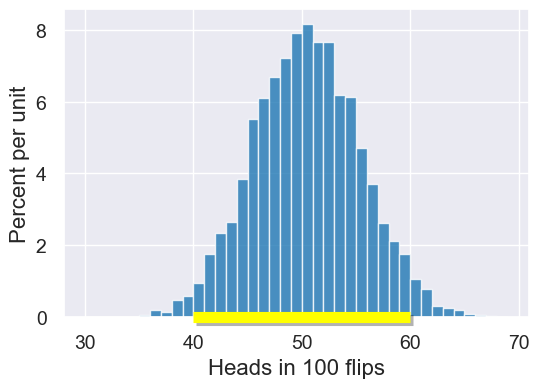
target_range = simulated_results.where("Heads in 100 flips",
are.between(40,60))
target_range.num_rows / simulated_results.num_rows
0.9536
5. A general simulation function#
Let’s make a reusable version of our simulation. That is, let’s make a function to do the work and produce the outcomes array. We can start with our simulation loop above:
outcomes = make_array()
num_trials = 10000
for i in np.arange(0, num_trials):
num_heads = heads_in_100_flips()
outcomes = np.append(outcomes, num_heads)
outcomes
array([52., 49., 57., ..., 51., 47., 55.])
This code depends on two pieces of information specific to the simulation we wish to perform:
the number of trials (
num_trials)the code to compute the outcome of one trial (eg:
heads_in_100_flips(). That code would need to change if we simulated the number of tails in 200 flips, the sum of 20 dice rolls, or any other kind outcome.
To enable us to use our general function with different numbers of trials or different functions to make the outcomes, we write the function with those two items as parameters:
def simulate(make_one_outcome, num_trials):
"""
Return an array of num_trials values, each
of which was created by calling make_one_outcome().
"""
outcomes = make_array()
for i in np.arange(0, num_trials):
outcome = make_one_outcome()
outcomes = np.append(outcomes, outcome)
return outcomes
We can then call simulate as follows:
simulate(heads_in_100_flips, 10)
array([48., 55., 53., 52., 55., 46., 60., 51., 49., 56.])
Or if we are interested in the sum of 20 dice rolls, we call it as follows:
dice = np.arange(1,7)
dice
array([1, 2, 3, 4, 5, 6])
def sum_twenty_dice():
roll_20_dice = np.random.choice(dice, 20)
return sum(roll_20_dice)
simulate(sum_twenty_dice, 5)
array([60., 77., 70., 74., 68.])
Notice how we can design new simulations without starting from scratch! We write a function to compute one outcome, and then reuse simulate with the number of trials we wish to perform.
And just for fun…
twenty_dice = simulate(sum_twenty_dice, 100000)
Table().with_columns('Sum of 20 dice', twenty_dice).hist(bins=np.arange(40,100,1))
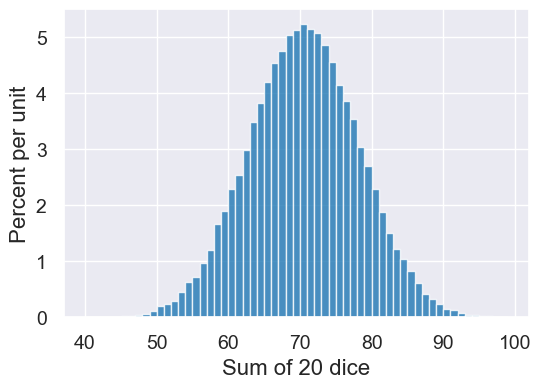
Does this look like any other histogram we saw today?


